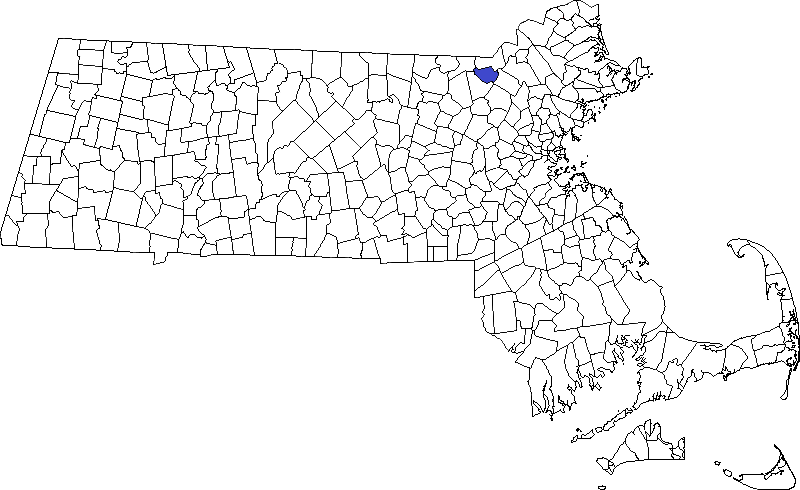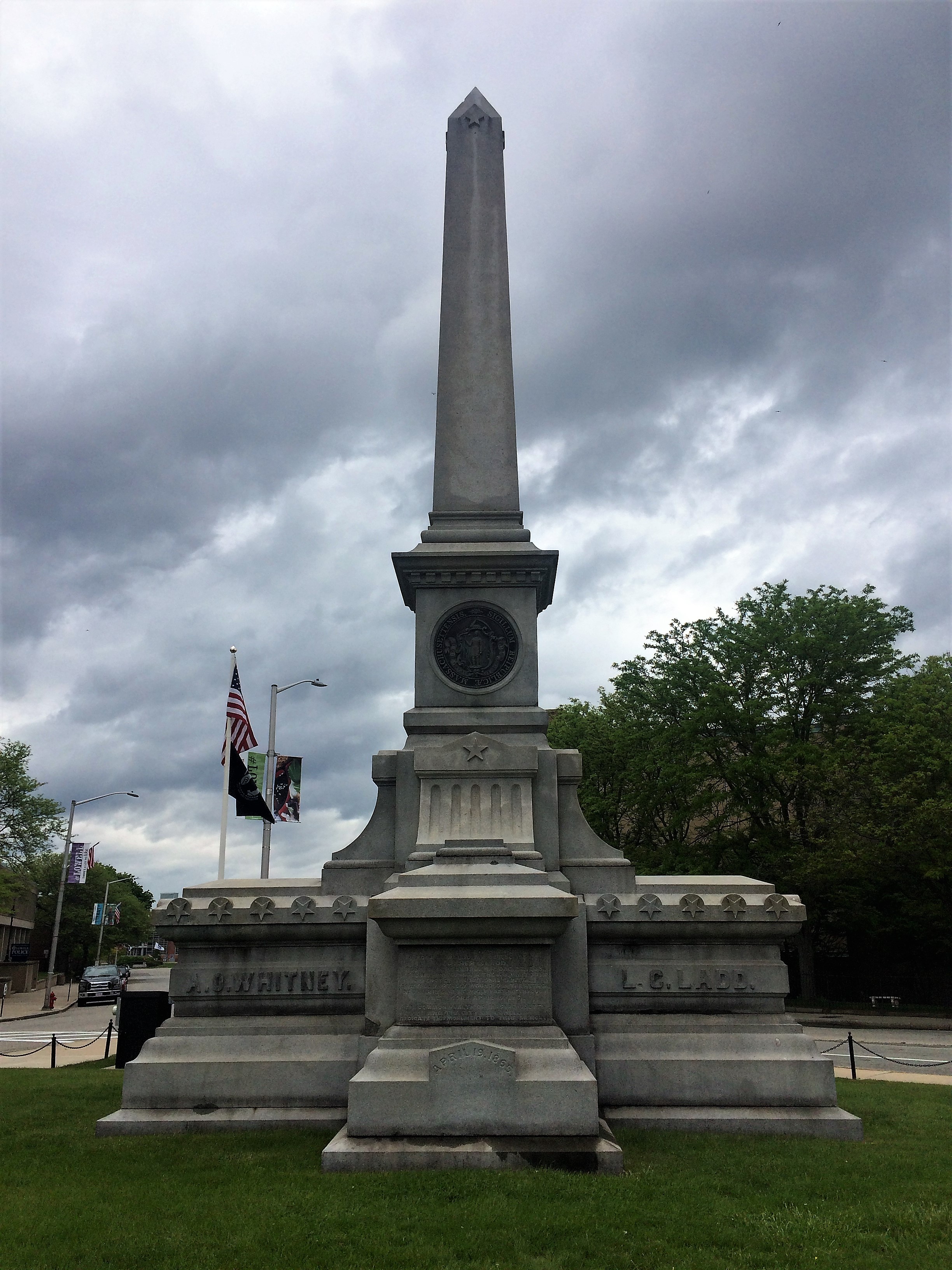
 Lowell Memorial Hall
Lowell Memorial Hall
Location: 401 Merrimack Street, Lowell
Coordinates: 42°38’47.2″N 71°18’53.6″W
Date dedicated: June 3, 1892
Architect/sculptor/manufacturer: Frederick Stickney (architect)
The cornerstone for the Lowell City Library (also known as Memorial Hall) was laid on October 11, 1890. It was dedicated on June 3, 1892 to all those from Lowell who died in the Civil War. Lowell native and well-known architect Frederick Stickney designed the Romanesque building. Among the numerous mansions and public buildings he worked on in New England and New York, Lowell’s Memorial Hall is arguably his grandest and best known building.
 Originally, the first floor housed the city library and the second floor housed a memorial meeting hall for use by the Grand Army of the Republic post. The treasured artifacts housed there included the coats worn by Privates Luther Ladd and Addison Whitney when they fell during the Baltimore Riot, becoming two of the first casualties in the Civil War.[1] A fire nearly destroyed the building in 1915. It was restored, although funds did not initially allow a full restoration of the hall’s original grandeur. The work in 1915 included the installation of military murals, still extant, by Paul Phillipoteaux, the artist who painted the famed Gettysburg Cyclorama. A full restoration of Memorial Hall’s interior, replicating the building’s original interior details, was accomplished in 1980.[2] In 1981 the building was renamed the Pollard Memorial Library after a former mayor of Lowell.
Originally, the first floor housed the city library and the second floor housed a memorial meeting hall for use by the Grand Army of the Republic post. The treasured artifacts housed there included the coats worn by Privates Luther Ladd and Addison Whitney when they fell during the Baltimore Riot, becoming two of the first casualties in the Civil War.[1] A fire nearly destroyed the building in 1915. It was restored, although funds did not initially allow a full restoration of the hall’s original grandeur. The work in 1915 included the installation of military murals, still extant, by Paul Phillipoteaux, the artist who painted the famed Gettysburg Cyclorama. A full restoration of Memorial Hall’s interior, replicating the building’s original interior details, was accomplished in 1980.[2] In 1981 the building was renamed the Pollard Memorial Library after a former mayor of Lowell.
 Ladd and Whitney Memorial
Ladd and Whitney Memorial
Location: Monument Square, Merrimack Street and Arcand Drive
Coordinates: 42°38’46.0″N 71°18’47.8″W
Date dedicated: June 17, 1865
Architect/sculptor/manufacturer: Unknown
Although monuments to individual soldiers are outside the purview of this project, an exception will be made in the case of the Ladd and Whitney Memorial due to its national historical importance and prominence in downtown Lowell.
Luther Ladd (17 years old) and Addison Whitney (22 years old) were both Lowell mill workers who signed up with the Lowell Guards, which became Company D of the 6th Massachusetts Volunteer Militia. On their way to Washington to answer Lincoln’s initial call for volunteer troops, the 6th Massachusetts was attacked by a secessionist mob in Baltimore. Four militiamen (including Ladd and Whitney) and at least 12 civilians were killed.
Ladd is frequently referred to as the first Union soldier killed in action during the Civil War, although some historians have questioned which of the 6th Massachusetts men fell first. In 1908, a plaque was attached to the monument in memory of another Lowell native who died that day–Private Charles A. Taylor. There is much confusion surrounding Taylor’s circumstances and he therefore has not received the same attention as Ladd and Whitney. He had just caught up with his unit that morning and therefore was in civilian clothing during the riot. It is believed that he was misidentified as a local civilian and buried in an unmarked grave. This greatly troubled Col. Edward Jones, commanding officer of the 6th Massachusetts, who for decades tried to locate Taylor’s grave in Maryland and return his remains to Lowell. Despite his efforts, Taylor’s grave was never located.[3]

Grand Army of the Republic Cemetery Plots
In addition to the above, Lowell also contains two stone memorials flanked by cannons which adorn the Grand Army of the Republic burial plots at Edson Cemetery (1375 Gorham Street) and Lowell Cemetery (1000 Lawrence Street). Among those interred in the Lowell Cemetery plot is U.S. Navy Capt. John McFarland who received the Congressional Medal of Honor for his courage and cool performance aboard Admiral Farragut’s flagship, the USS Hartford, during the Battle of Mobile Bay. McFarland’s marker, back in 1885, had been incorrectly carved with the name “William McFarland” and the Medal of Honor recipient’s resting place therefore disappeared from record…until 2017 when a group including local historians, veterans, and cemetery department staff got to the bottom of the mystery. A corrected grave marker for McFarland was placed appropriately noting his status as a Medal of Honor recipient.[4]
[1] Alfred S. Roe, Monuments, tablets and other memorials erected in Massachusetts to commemorate the service of her sons in the war of the rebellion, 1861-1865, (Boston: Wright and Potter Printers, 1910), 70.
[2] Lowell Historical Society, Lowell: The Mill City, (Charleston, SC: Arcadia Publishing, 2005), 46-48.
[3] David Pevear, “The First of So Many to Fall,” Lowell Sun, April 17, 2011
[4] James Sullivan, “Finding the proper resting place for a Civil War hero,” Boston Globe, November 3, 2017
Patrick, thank you and Jeff for pursuing this important project of documenting all of MA Civil War Monuments. The CT Historical Society published its project of our CT monuments in a 2 vol. cloth set. Hopefully, one day a similar organization will do your project the same justice. Thank you again!
Thank you, Irving! Glad you enjoy the posts.